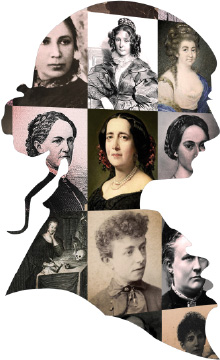Lela Davičo
1850–1940
| Pseudonyms | Alma, Kolomba |
|---|---|
| Spouse | Hajim S. Davičo |
| Other names | Adel Gold |
| Date of birth | May 03, 1850 |
| Date of death | 1940 |
Personal situation
On May 3, 1850 or 1856, Lela was born as Adele, in Pest, to Joseph and Babette Gold, née Kohn. Her father was a merchant. She was the eldest of her siblings, Ana and Gyula, after an early death of her sister Mathilde.
On June 25, 1872, Lela got married in Pest to lawyer Miksane Somogyi. They had three children: daughters Malvina and Hedvig, and son Imre.
On December 31, 1886, she divorced her first husband.
On March, 1887, Lela got married to Hajim S. Davičo in Budapest.
For a short period of time, somewhere between 1888 and 1889, she lives in Rome, where her husband works as a secretary of delegation, only to move back again to Budapest.
From 1892 to 1897, she lives in Belgrade.
From 1897 to 1900, she lives in Trieste, where her husband works as a general consul.
From 1903 to 1914, she lives in Munich, where her husband at first works as a consul, and later as a trade representative. During her stay in Munich, she kept correspondence with distinguished people of her time such as Vladan Đorđević, Ricarda Huch, Ermanno Ceconi and Michael Georg Conrad. She also used to know Oscar Schmitz, who even mentions her in his diaries.
Around 1915, for a short period of time she lived in Berlin, where her husband worked as a Serbian trade representative.
Since 1915, Lela lives in Geneva.
In 1918, she was widowed, after her husband had passed away.
In 1940, Lela was still alive.
| Place of birth | Budimpešta |
|---|---|
| Place(s) of residence | Serbia |
| Place of death | Ženeva |
| Nationality | Austro-Hungarian |
| First language(s) | German |
| Marital status | Remarried |
| Number of children | 3 |
| Name(s) of children | Hedvig, Malvina, Imre |
| Gender of children | ženski (2), muški (1) |
| Social class | Upper class |
| Education | School education |
| Religion | Jewish |
Professional situation
Until 1887, she had been working for “Budapest daily newspaper” (german: Budapester Tagblatt), where she used to publish her texts by the pseudonym Alma.
In 1887, she publishes a play „Dance evening”.
In 1892, she takes part in forming the first Serbian Community for Literature and Art. On its meetings, like many other members, she reads her texts.
In 1893, she publishes a text in Smiljevac, named “Two female portraits”, which consists of two parts named “Famous for her beauty” and “The unknown woman”.
In 1903, she publishes three literary texts in the periodical Brankovo kolo, named “The routine”, “The sphinx”, “A love night: the sketch from seaside”. That same year, but in the periodical Nova iskra, she publishes the text “Great happiness, a family picture”.
Since 1903, begins the most fruitful period of the author’s carrer, although she writes almost exclusively in German and publishes in German periodicals. She writes an essay published as a short monography “Die Tugendhaften”, as well as numerous short plays, narrative works and texts from the domain of literarary criticism.
In 1908, she publishes the text called “Serbian women” in the periodical Domaćica, which was previously published in German.
Research done by Biljana Skopljak.
| Profession(s) and other activities | poet, journalist, contributor to periodical press, playwright, and musician/composer |
|---|---|
| Language(s) in which she wrote | German and Serbian |
| Financial aspects of her career | Stipend/allowance/pension and Salary |
| Memberships | associations/organizations |
Works by this author
Monographs
- Die Tugendhaften 1900.
Articles and other similar texts
- Skizze 1904
- Balska noć 1887.
- Dva ženska portreta 1893.
- Pesnik i žena 1894.
- Navika 1903.
- Therftan Effendi 1903
- Velika sreća: domaća slika 1903.
- Jedna ljubavna noć: skica sa primorja 1903.
- Sfinga 1903.
- Die Selbstmörderin 1904
- Die gelbit mörderin 1904
- Das Tränenparadies 1904
- Die Quelle des Lebens 1905
- Schwankende Gestalten 1906
- Münchner Malerinnen: Ida Klaus 1906
- Aneinander vorbei 1907
- Die sie sich seh'u 1907
- Srpske žene 1908.
Reception
Reception after death
Authors read by this author
* Only authors in Knjiženstvo DB are shown


